VFX supervisor Seth Maury at MPC Vancouver reveals the inner magic that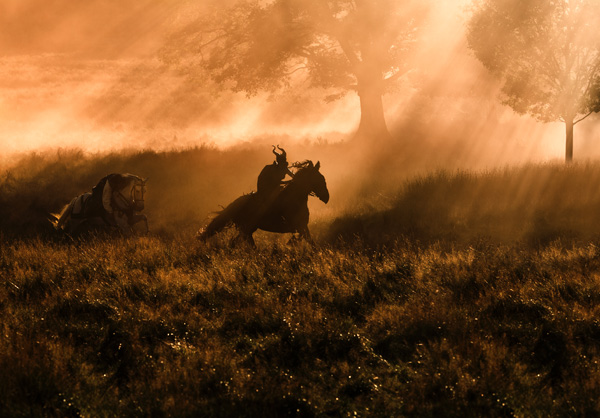
makes the two worlds of ‘Maleficent’, their fairies, creatures and enchanted
effects all come to life.
MPC Makes Worlds Collide for ‘Maleficent’ |
|
MPC handled a huge range of tasks for ‘Maleficent’, including 3D builds of two fairy tale worlds. One was the rolling green country surrounding massive Sleeping Beauty castle, and the other was the Moors, home of Maleficent and an enchanted forest. As well as environments, the MPC team created and animated a range of fairies and other creatures, the castle itself, diverse dynamic effects employing proprietary tools, and Diaval the Raven’s human-to-bird transformations. The numerous complex effects shots occupied MPC’s team at both the London and Vancouver facilities. |
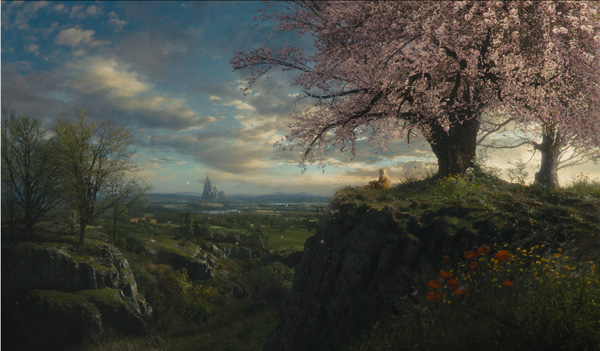 |
|
Fairy CharactersResponsible for most of the environments in the movie, MPC’s teams in London and Vancouver kept in daily contact to discuss style considerations, make sure they were visually differentiating between the Moors and the human world, and that the design elements of each were distinct. Also, as the cut evolved, so did the needs of the environments, either for continuity or to make them more or less similar to surrounding shots and scenes. As a result, because the fairies’ looks and lives are closely linked to their environment, the character design evolved as well over the entire course of the film, as the team continually refined the human and fairy world looks and contents. |
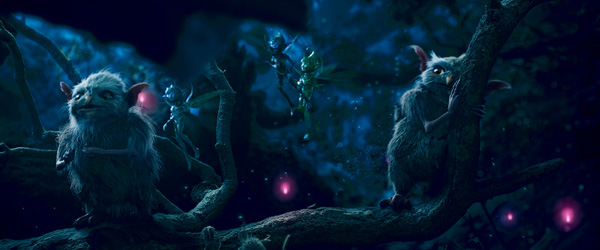 |
|
“Because the most successful geometry variations are those that change the profile or silhouette, we looked for ways to alter the clothing or hair so that they would look different at a distance. Our colour changes were often more subtle, to make them feel as if they all belonged to same group. We tried to keep textures grounded in real-world materials. For instance, the Stone Fairy had a stone quality to his surface; essentially matching the texture quality to the model quality. As they didn’t have speaking lines, we had to design, rig and animate them to be as expressive as possible through motion.” |
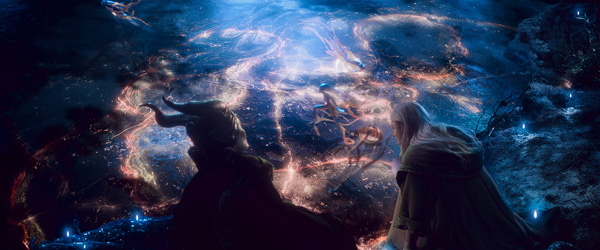 |
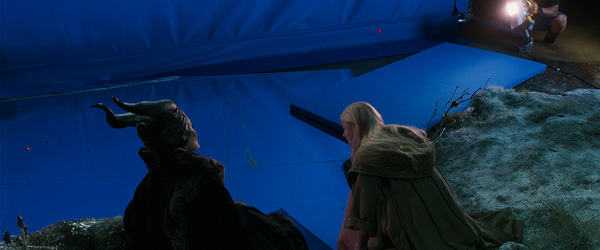 |
Immersive MovesMPC’s current pipeline - modelling in ZBrush, then moving on to Maya - achieved the character builds, and the animation was also done in Maya, augmented with a number of proprietary tools. “For the most part, the fairies our team created were keyframed, although we did use motion capture for much of our crowd work, either mocap clips we have in the MPC library or actions we shot specifically for this movie. For instance, for the battle scene, we were able to use clips we already had of soldiers riding on horses, but needed new animation of soldiers swinging swords and running and jumping in the style of the practical actors’ performance,” Seth said. MPC created some fascinating water fairies in very wide shots in which we see Maleficent flying past overhead. Their approach required first working out the camera moves. Robert Stromberg and Carey Villegas wanted to bring the audience along on the flight, to feel as though they were participating in it, so the camera moves and the environment, which in these shots was created at Digital Domain, were tailored to feel immersive. Then they started to add in the secondary elements, like CG water and the water interactions, done in-house with a mix of FlowLine and Maya Fluids and particles. |
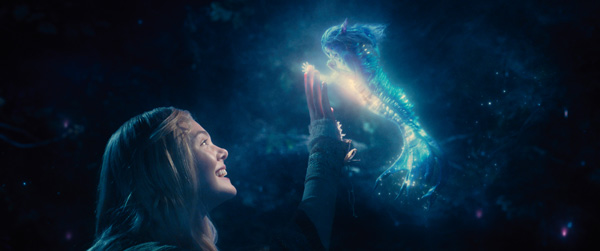 |
|
Forest DwellersStill other, illuminated fairies, seen in a night sequence, were developed through exploration to find what their motion and action would be, from fantastical to more realistic, like ice skaters, until they finally landed somewhere in between. “Adam and the animation team in London explored this character very thoroughly. We found that if at least some of their motion wasn’t grounded in how people expected that kind of creature to move, then it wasn’t believable enough, even in a fantastical fairy world,” Seth said. |
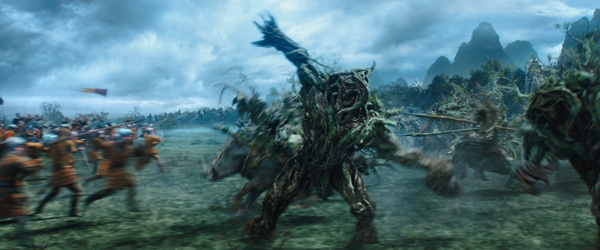 |
|
“We went with a model and texture similar to the surrounding environment, but then played with lighting and atmospheric depth cueing to get them to stand out and separate. We didn’t use much shallow depth of field, since it tends to miniaturize things, and we wanted this environment and these creatures to feel big, weighty and threatening. In a few cases we did want them to blend into the environment, like the shot where they initially emerge from the forest. That was a fun one to play with lighting and composition in terms of imagery going from homogeneous to distinct,” he said. |
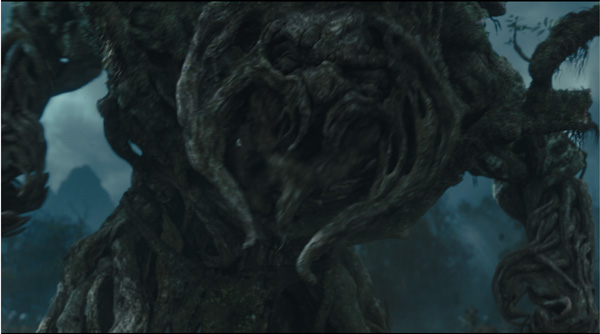 |
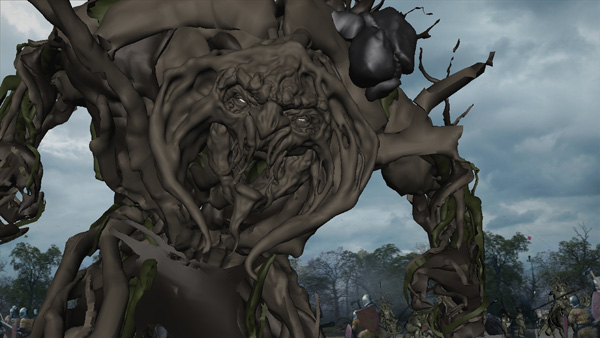 |
|
Diaval the RavenDiaval the Raven, Maleficient’s friend, henchman and closest ally, was a different type of character all together. He transforms at her will between his native raven shape and his human form, which she creates for him with magic. For the raven, Adam Valdez and Seth both wanted to start with live action reference of a real raven. Adam brought a raven with a trainer into the studio to capture stills and video. The team then roto-animated or eye matched a lot of those captured motions as the basis of the character. |
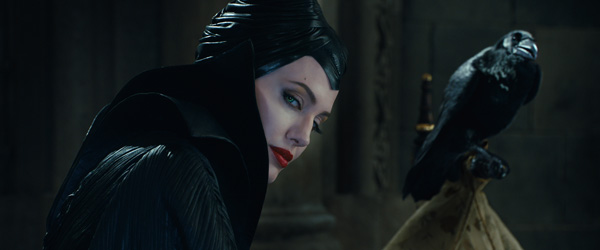 |
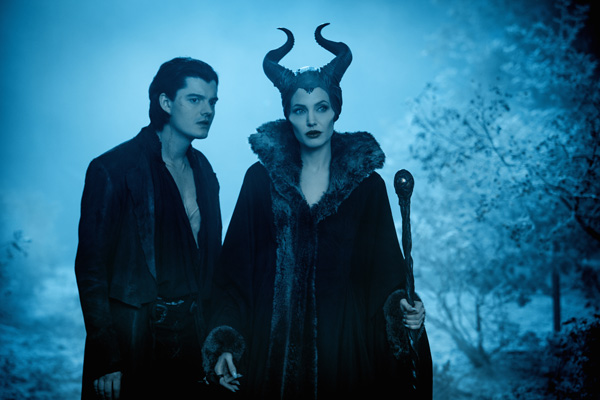 |
|
Each transformation was done specifically for the shot type. First they blocked out the timing with Carey, and then discussed the specifics such as which body parts would come through first, or whether it should happen from the ground up or from the head down, and so on. “Initially we thought we’d be covering the transitions with effects but as we went along, we kept clearing away more and more of the effects until the transitions were almost completely clean. The Diaval bird-to-human transition, for example, was done with specific rigs, models and blend shapes to be able to transition between the bird model and our model of the actor. We defined intermediate target poses, and then produced animation controls to block them out. Ultimately, much of the work of this sort of transition is done in compositing, and it’s still quite a manual process in our case.” |
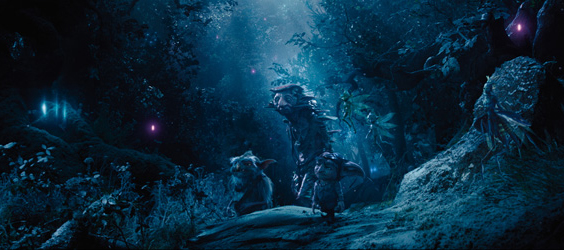 |
Going UndergroundWhen some of the creatures burst up out of the ground during the battle scene to defend the Moors, MPC created ground explosions with a mix of 3D simulations and 2D practical plate elements. The simulations employed their in-house FX tool called Kali, essentially a finite-element solver. “We can define all different kinds of material properties, and then model the geometry as needed to define different layers of grass clumps, dirt, rocks and so on,” said Seth. “Since the show was a stereo release, it was important to do as much of this kind of work in 3D as possible - otherwise the effects are more difficult to convert. We also used practical plate elements, both some that Carey had shot on 2nd unit and others from our internal plate element library to supplement. For reference, we used the practical of course, but I also spent a lot of time looking at building demolitions to look at what the charges looked like when they went off, to get that explosive feel.” |
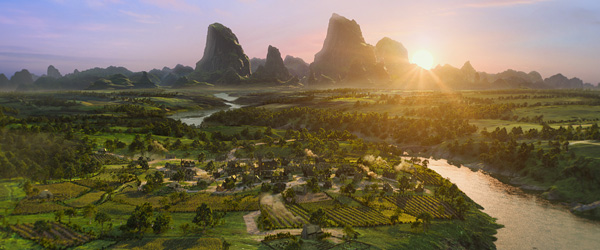 |
Worlds ApartThe two environments were designed so that, as the story unfolds, viewers can quickly identify whether the action is taking in the fairy world or the human world. They received lots of input on this aspect of the project from the director, production VFX supervisor Carey Villegas and Dylan Cole. The human world is intended to look as much as possible like the English countryside, whereas the fairy world incorporates fantastical elements that aren’t seen every day. MPC’s 3D human world is made up of plates and matte paintings sourced from many locations around England and Europe. The fairy world is based on concepts and matte paintings from Dylan and Rob Stromberg, and additional material from all kinds of sources. “For example, the CG plant library made for the movie has two different styles,” explained Seth. “In the fairy world, trees and plants have particular shapes and branch patterns, quite different from real life, that serve as visual cues to tell you which world you are in at any moment. A great deal of the specifics of what makes each world feel like it does were, in fact, worked out after the cameras and previz were done. The camera work done in previz mostly defined the shot and the camera style, and we filled in the environment after, since we were all working on camera and environment in parallel. In some cases though, like the fairy mound itself, we built the mound early on, and then designed camera moves to work within our geometry. |
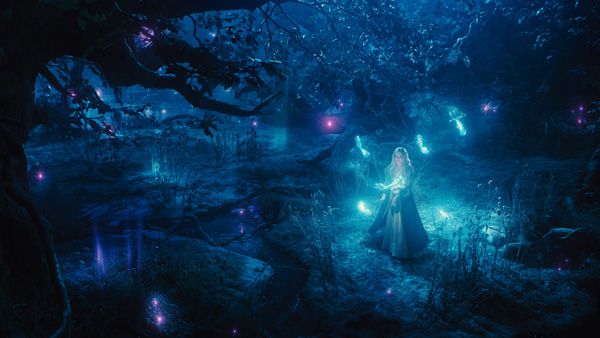 |
|
“While we had a map for the environment and for the world that Maleficent inhabited, the whole scene didn’t live together in one file. Each location was its own build. Many times when you look from fairy world to castle, or from castle to fairy world, we established a rough visual distance for how far apart the worlds are. But we then adjusted it as needed for good shot composition, and for storytelling purposes. So sometimes in a night scene, we might bring the silhouetted castle on the horizon a bit closer to seem more imposing than it might feel at its regular distance away. “The final shots were almost always a combination, based a matte painting split up into multiple levels and either placed on cards in a 2.5 D system or projected onto 3D geometry. On top of that, we added 3D elements all around to help with parallax and add life to areas of the frame that were too static. In this way, despite working on a stereo show, our use of matte paintings wasn’t necessarily limited, since we paid a lot of attention to how we implemented those matte paintings and how we dressed the environment around the painted elements.” |
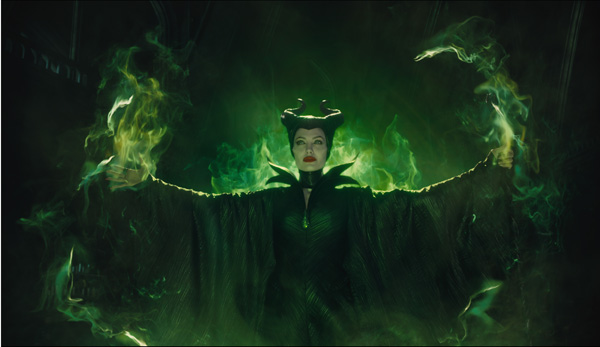 |
Green CurseThe green curse effects, among the most powerful visualisations of Maleficent’s magic, are based on many influences. The team first turned to Walt Disney’s original animated ‘Sleeping Beauty’ to see what kind of feel, character and animation the original effects had, and how active and how big they were. “The flames themselves were very active and supported the emotion of the scene, but didn’t have a lot of internal detail. We started with a concept drawing of the shape Rob wanted the effect to have – an elliptical shape we called the parentheses. It’s useful for us to have that basic shape to use as a target shape for the effects to form into, and also as an emitter for other particle FX,” Seth said. “We had many layers of effects going on, some larger gas or fire-like elements, and then smaller ‘smarticles’ that were more individual in their animation and motion. The base effects were green and the smarticles were bluer to help bring out depth in the image. The effects were done as a fluid simulation, so we start out fire-like, then alter it to run slower and change the shape of that fire to create a surreal look. “The dramatic shot in which Maleficent actually curses the baby is made up of inspirations from different images I’ve seen. The main part is a fluid simulation, similar to ink tank footage. I really love that slow motion fluid feel - you get such pretty shapes and colour combinations. We supplemented that with trails of smoke, like you get from burning pieces falling from large objects. I wanted the curse magic in that shot especially to have weight and density, but feel flowing and slow at the same time. We didn’t have much interactive practical set light for a lot of these shots, so we added it in post later on as needed.” |
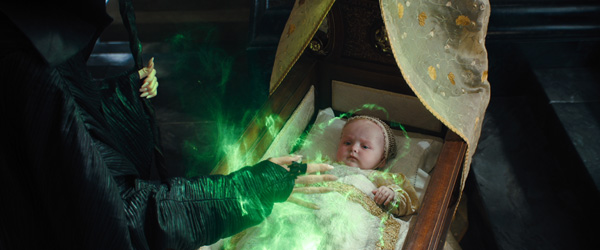 |
|
Wall of ThornsThe wall of thorns that Maleficent controls to protect the Moors from the king’s army is extremely complex, extending far into the distance, and appears to have a life of its own as it grows into an impenetrable barrier. “Having previously worked on Jack the Giant Slayer, we had a bit of experience with a large vine growing system,” explained Seth. “The shortcoming of that system was how heavy all the geometry was and the tremendous difficulty we had in rendering. "David Seager, our CG supervisor, came up with the idea of using our proprietary crowd system called Alice instead, to create the wall on the wide shots. In animation, we created the motions of the vines exploding out of the grounding, expanding, growing and twisting, and then fed it into the crowd system as an agent. The advantage there is that the crowd system knows how to handle levels of detail and instancing within our pipeline, so we were able to leverage a system we already had in order to render these large scenes. Meanwhile, the medium and tighter shots were all hand animated to get a real sense of density and as many stereoscopic moments as we could. |
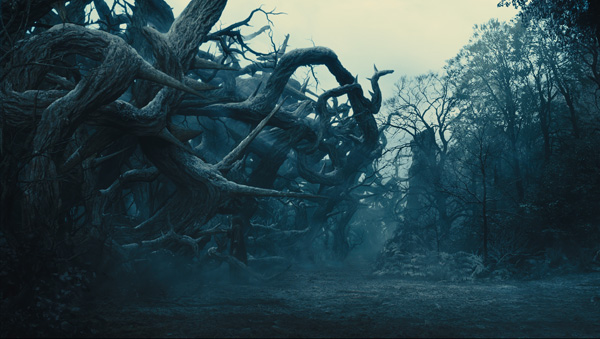 |
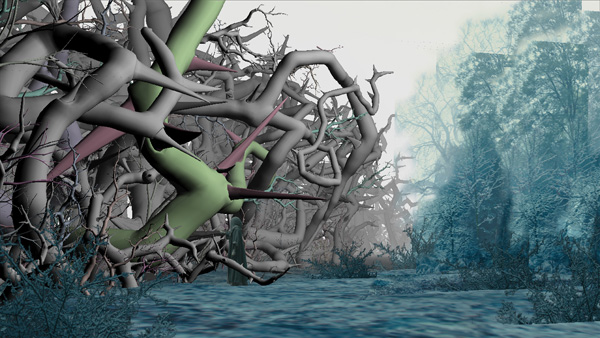 |
|
Sleeping Beauty CastleMPC worked on the castle and the shots of the castle throughout post production. Some early previz was provided, but they also had a description from Rob referring to large, sweeping Harry Potter-type castle approach shots. “The production was keen to keep the castle cameras constantly alive. So once I had an idea of what each of the castle shots were, I went through all the second unit footage and found practical plates for as many shots as I could, and matte paintings were used for any backgrounds we needed to supplement,” said Seth. “Dylan Cole gave us some concepts for the design, which always had a triangular silhouette, no matter what angle it was viewed from on the horizon. These views helped us establish the important side of the castle. We started building that first and then, of course, ended up building the whole castle in high detail and texture, since we eventually see it from every angle. |
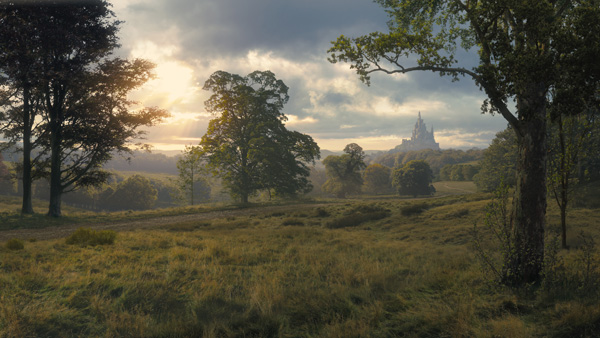 |
|
Coronation DayFor the establishing shot just before Aurora’s coronation, multiple versions of the camera were produced until they hit on an ideal angle expressing the grandeur and importance of the day. The time of day, mid-afternoon, was also important. Following some lighting tests, the sun was placed in a back 3/4 position chosen to bring out the most attractive features of the castle, and to illuminate the front of the structure at the end of the shot, making it bright but not flat. More fill light was brought in to the courtyard area, which physically would have been much darker than the original exposure, but they needed to see into those shadows to show the numbers of people approaching and to climb the steps to the entrance of the hall. |
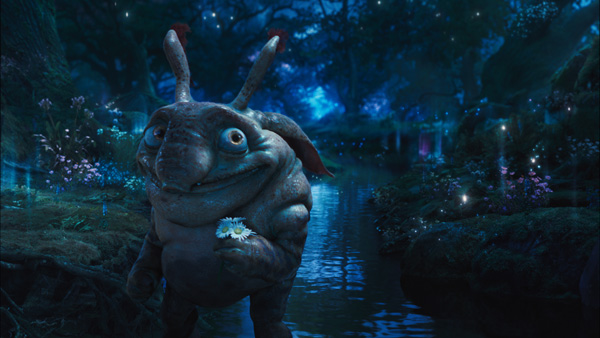 |
As every Disney fan knows, the company’s logo is based on a stylised rendition of Sleeping Beauty castle. At the start of the film as the camera glides in toward the logo the audience watches that castle and the scene around it transform into the story’s detailed scenery and a somewhat different castle. “This was one of the last shots we did. We took the castle model we had been working on, broke it into modular pieces and then moved them around to find a hybrid between the Disney logo and the movie’s castle that worked for the shot framing and also worked with all the existing elements from the logo that couldn’t be changed. By the end we came up with an elegant flyover of the castle revealing the fairy world, with a good lighting transition from the Disney logo style to the darker, moodier Maleficent style.” moving-picture.com |
| Words: Adriene Hurst Images: Courtesy of Walt Disney Pictures |


















